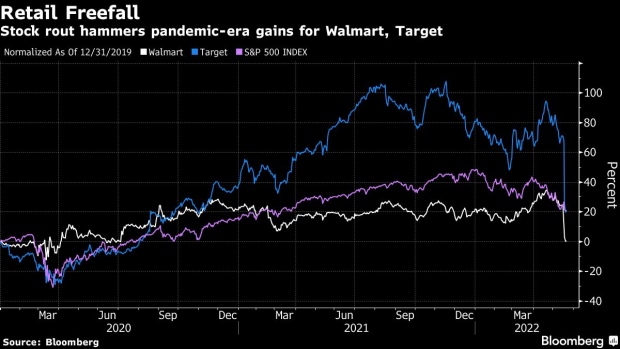May 21, 2022
More Horrors Await After $550 Billion Retail Earnings Meltdown
, Bloomberg News

(Bloomberg) -- Soaring costs and swollen inventories have retailers on the ropes, and investors fear that the punishment won’t ease anytime soon.
With companies from Costco Wholesale Corp. to Dollar General Corp. and Best Buy Co. set to report earnings next week, investors are bracing for more bad news after a disastrous few days that sent giants like Walmart Inc. and Target Corp. to their worst stock-price drops since 1987.
In all, some $550 billion in market value was erased from consumer stocks over the past five days, adding to the downward pressure on a market already strained by fear of inflation and rising interest rates. On Friday, the S&P 500 -- weighed down by the heavy losses in its consumer sectors -- briefly dipped into bear-market territory, a 20% decline from its most recent high.
“This week has been an absolute bloodbath for retail,” said Neil Saunders, an analyst at GlobalData Plc. “To a certain extent, I think that’s the rebalancing of expectations, and people seeing more crimp on profit.”
Part of the problem is that stores are awash in products that consumers don’t want. At the same time, the cost of finding new goods to sell and getting them into stores is surging as fuel, labor and other expenses climb. Walmart and Target both slashed their forecasts for profit this year as inventories ballooned and price increases failed to keep up with rising costs.
That has investors on edge over how other companies might hold up. Dollar General and Dollar Tree Inc. are each set to report on Thursday, days after being swamped in the selloff that took down Target. There is also unease over long-struggling department stores -- Nordstrom Inc. reports Tuesday and Macy’s Inc. is slated for Thursday -- as well as specialty chains such as Best Buy and Dick’s Sporting Goods Inc. Costco, also on Thursday, is the largest retailer on the docket for next week.
Here is more on some of the key issues facing US retailers right now:
Costs
Walmart and Target are seen as some of the savviest supply-chain managers in the business, and they’ve been contending with disruptions since the pandemic began. Even so, they were caught flat-footed when oil prices surged after Russia’s invasion of Ukraine.
More retailers will likely be forced to cut their forecasts to account for increases in fuel and freight costs, which show no sign of abating soon, Saunders said. Price hikes won’t be able to cover the full brunt of this challenge, he said.
Spending Patterns
The rising cost of everything is forcing shoppers to make tough decisions. While overall US retail sales remain robust, Walmart and Target both said more customers are trading down to cheaper, private-label groceries.
“The needs are squeezing out the wants,” said Michael Baker, an analyst at D.A. Davidson.
A shift to more bargain-focused shopping could bode well for Dollar Tree and Dollar General. At the same time, upscale retailers like Nordstrom will be watched closely to see if there are more signs that well-heeled consumers are keeping up their spending while others turn cautious.
Another watch item: the weather. Walmart and Target blamed damp, chilly conditions in early spring for crimping sales in certain categories. That could be a problem for apparel sellers such as Gap Inc., Urban Outfitters Inc. and Abercrombie & Fitch Co., which also report next week.
Inventories
Shipping delays and backlogs were so bad last year that Walmart and Target chartered cargo ships to keep their shelves stocked. That worked for a while, but this year inventories are getting out of hand.
The retailers now find themselves flush with clothes, televisions and other discretionary items that customers aren’t buying as they channel more spending into basic needs and services. As a result, the companies took markdowns that eroded profits.
It’s possible that Costco dodged some of that pressure since its narrower range of items gives it more flexibility, said Jennifer Bartashus, an analyst at Bloomberg Intelligence.
“We’re going to be thinking a lot more about inventory and the markdown risk that may be associated with inventory,” Bartashus said. “That will be an overhang for earnings next week, and it will be an overhang later into the year as well.”
©2022 Bloomberg L.P.


